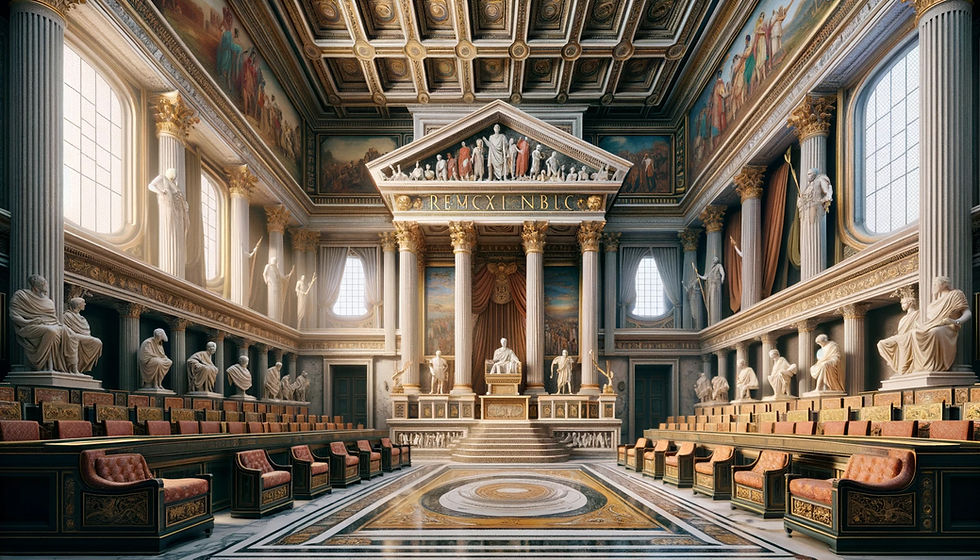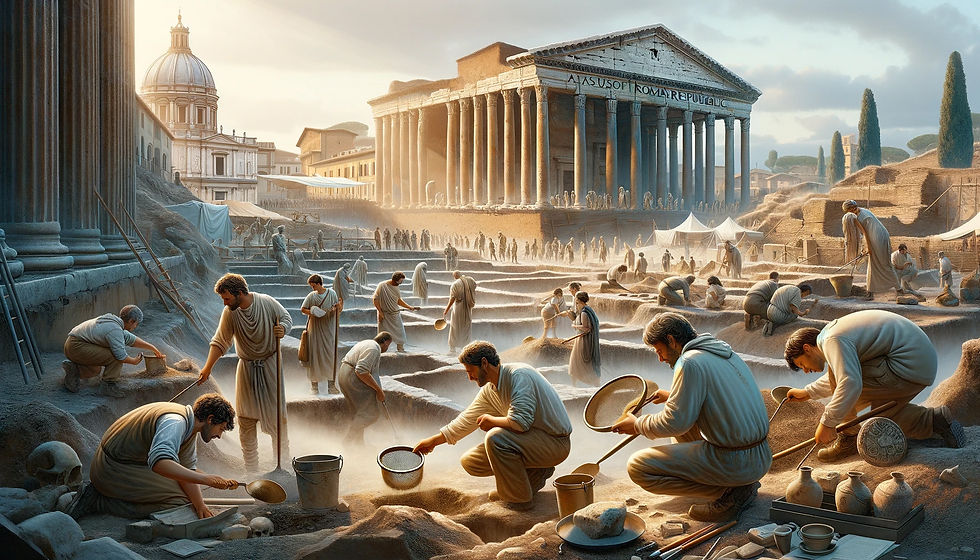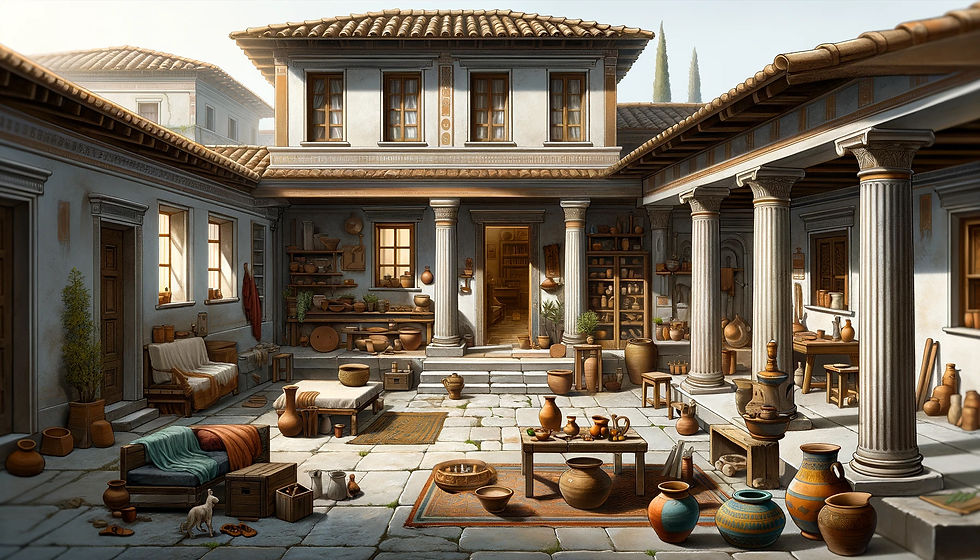Lesson Plans of Ancient Roman Civilization: The Roman Republic
- Historical Conquest Team

- Mar 16, 2024
- 12 min read
Updated: Apr 20, 2024
The Roman Republic stands as a pivotal chapter in the annals of history, serving as a cornerstone for the development of political systems, the concept of citizenship, and the growth of Roman influence across the Mediterranean. Spanning from 509 to 27 BC, this period emerged from the ashes of monarchical rule, introducing a republican form of governance that shaped the destiny of Rome and echoed through the corridors of time.

At its core, the Roman Republic was a testament to the triumphs and tribulations of a fledgling democracy. Its genesis was heralded by the overthrow of the Roman Kingdom in 509 BC, a watershed moment symbolizing the rejection of autocratic rule in favor of a government by the people, for the people. The establishment of the Republic ushered in an era of political innovation, as power shifted from monarchs to elected officials, primarily consuls and senators, who wielded authority under the scrutiny of a burgeoning citizenry.
One of the defining features of the Roman Republic was its relentless expansionism. Fuelled by a desire for territorial aggrandizement and economic prosperity, Rome embarked on a campaign of conquest that saw its dominion stretch from the Italian peninsula to the far reaches of the Mediterranean basin. Through military prowess and strategic acumen, the legions of Rome subjugated neighboring states, established colonies, and imposed their will upon diverse cultures, leaving an indelible mark on the map of antiquity.
Yet, the Republic was not immune to internal discord. A perennial struggle between the Patricians, the aristocratic elite, and the Plebeians, the common people, underscored the socio-political landscape of Rome. This class conflict, punctuated by agrarian reforms, the formation of tribunes, and the struggle for political representation, epitomized the perennial tension between privilege and populism, shaping the trajectory of Roman governance.
Furthermore, external threats loomed large on the horizon, testing the resilience and fortitude of the Republic. Rival powers such as Carthage in the Punic Wars and the Hellenistic kingdoms in the East challenged Roman hegemony, igniting conflicts that would define the fate of civilizations. These conflicts not only shaped the geopolitical landscape of the ancient world but also catalyzed profound transformations within Roman society, from military reforms to shifts in political ideology.
Studying the Roman Republic offers invaluable insights into the complexities of governance, the dynamics of power, and the nuances of societal evolution. It underscores the enduring legacy of republican ideals, the perils of unchecked ambition, and the interplay between tradition and progress. Moreover, it serves as a cautionary tale, reminding us of the fragility of democratic institutions and the consequences of political instability.
In conclusion, the Roman Republic stands as a beacon of civilization, a testament to the aspirations and aspirations of a people who dared to defy tyranny and forge a new path towards collective governance. By delving into its history, we unravel a tapestry of triumphs and tribulations, offering invaluable lessons for generations to come.
Global Events During this Period
During the existence of the Roman Republic from 509 BC to 27 BC, the world was witnessing several significant events and developments across various regions. Understanding the broader historical context during this time period is crucial for comprehending the complexities and influences on the Roman Republic. Here are some key events from around the world during the era of the Roman Republic:
1. Greco-Persian Wars (499–449 BC): The Greco-Persian Wars were a series of conflicts between the Greek city-states and the Persian Empire. Beginning with the Ionian Revolt in 499 BC, these wars culminated in the famous battles of Marathon (490 BC) and Thermopylae (480 BC). The Greeks ultimately repelled the Persian invasions, preserving their independence and influencing the political landscape of the Eastern Mediterranean.
2. The Peloponnesian War (431–404 BC): The Peloponnesian War was fought between Athens and its Delian League allies against the Peloponnesian League led by Sparta. Lasting for nearly three decades, this conflict reshaped the balance of power in ancient Greece. It resulted in the decline of Athens as the dominant city-state and ushered in a period of Spartan hegemony in the Greek world.
3. Conquests of Alexander the Great (334–323 BC): Alexander the Great, king of Macedon, embarked on a series of military campaigns that resulted in one of the largest empires in history. Beginning with the invasion of the Persian Empire in 334 BC, Alexander's conquests spread Greek culture across the Near East, Central Asia, and Egypt. His empire facilitated the spread of Hellenistic culture and ideas, which would later influence the Roman Republic.
4. The Qin Dynasty in China (221–207 BC): The Qin Dynasty marked the unification of China under the rule of Qin Shi Huang, who declared himself the first emperor of China in 221 BC. Known for centralizing power, standardizing laws, and constructing the Great Wall, the Qin Dynasty laid the foundation for imperial rule in China, setting a precedent for centralized governance that would endure for centuries.
5. The Punic Wars (264–146 BC): The Punic Wars were a series of conflicts between Rome and Carthage for dominance in the Western Mediterranean. These wars, particularly the Second and Third Punic Wars, resulted in the destruction of Carthage and the expansion of Roman influence across the Mediterranean basin. The Punic Wars played a pivotal role in shaping Rome's destiny as a dominant imperial power.
6. The Maurya Empire in India (322–185 BC): The Maurya Empire, founded by Chandragupta Maurya in 322 BC, marked a significant period of Indian history. Under the rule of Emperor Ashoka, the empire expanded to encompass most of the Indian subcontinent. Ashoka's conversion to Buddhism and his advocacy of nonviolence left a lasting impact on Indian society and culture.
7. The Hellenistic Period (323–31 BC): Following the death of Alexander the Great, his empire fragmented into several successor states known as the Hellenistic kingdoms. This period witnessed the spread of Greek culture across the Eastern Mediterranean and beyond, blending Greek traditions with local customs to create vibrant new societies and cultures.
These events, among others, provide a broader context for understanding the dynamics of the Roman Republic and its interactions with the wider ancient world. Studying these events illuminates the interconnectedness of civilizations and the profound impact of historical developments on subsequent eras.
Important People During this Period
Studying the Roman Republic period (509–27 BC) is crucial for understanding the foundations of Western civilization. During this transformative era, Rome evolved from a monarchy to a republic, shaping its political, social, and cultural landscape for centuries to come. Delving into the lives of key figures from this period offers valuable insights into the dynamics of power, governance, and societal change.
1. Lucius Junius Brutus: Often hailed as one of the founders of the Roman Republic, Lucius Junius Brutus played a pivotal role in overthrowing the last Roman king, Tarquin the Proud, in 509 BC. He served as one of the first consuls of the Republic and is renowned for his commitment to republican principles, symbolized by his willingness to execute his own sons for conspiring with the Tarquins.
2. Gaius Julius Caesar: A towering figure in Roman history, Julius Caesar was a brilliant military strategist, statesman, and orator who rose to prominence during the late Republic. He played a central role in the downfall of the Republic through his ambitious political maneuvers, military conquests, and reforms. Caesar's assassination in 44 BC marked a turning point in Roman politics, leading to a series of civil wars and ultimately the rise of the Roman Empire.
3. Cicero: Marcus Tullius Cicero, a renowned statesman, lawyer, and philosopher, emerged as one of the most influential figures of the late Republic. His eloquent speeches and writings championed the principles of republican governance, constitutionalism, and the rule of law. Cicero's works, including his philosophical treatises and letters, provide invaluable insights into the political and intellectual climate of the time.
4. Gaius Marius: Gaius Marius, a celebrated military leader and statesman, reshaped the Roman military and political landscape during his consulships in the late 2nd century BC. He introduced significant reforms to the Roman army, including opening recruitment to landless citizens, which had far-reaching consequences for Roman society. Marius's military successes and political influence paved the way for the rise of popular leaders in Roman politics.
5. Gnaeus Pompeius Magnus (Pompey the Great): Pompey, a brilliant general and statesman, played a prominent role in the late Republic's political struggles. His military campaigns expanded Rome's territories in the East, earning him the title "Magnus" or "the Great." Pompey's alliance with Julius Caesar and later rivalry contributed to the collapse of the Republic and the transition to imperial rule.
6. Spartacus: Spartacus was a prominent figure in Roman history, known primarily for leading a slave uprising against the Roman Republic in 73-71 BC. Born into slavery, his early life remains largely obscure. However, he became a gladiator and eventually escaped captivity, rallying thousands of slaves to his cause. Spartacus and his followers, often referred to as "Spartacus' revolt," challenged the Roman legions in a series of battles, achieving notable victories and causing significant disruption across Italy. Despite initial success, Spartacus' rebellion was eventually crushed by the Roman forces, leading to his death in battle. Despite his defeat, Spartacus' legacy endured as a symbol of resistance against oppression and injustice.
Studying these individuals allows us to explore the complexities of leadership, the dynamics of power, and the ideological tensions that defined the Roman Republic. Their legacies continue to shape our understanding of governance, citizenship, and the challenges of political change in modern societies. By examining their lives and contributions, we gain valuable insights into the enduring principles and challenges of democratic governance.
Archeological Findings About this Period
Studying the Roman Republic (509–27 BC) offers a captivating journey into one of the most influential periods in human history. From its humble beginnings after the overthrow of the monarchy to its transformation into a mighty empire, the Roman Republic shaped the course of Western civilization. Exploring this era unveils significant events, key figures, and archaeological findings that shed light on its complexities and enduring legacy.

Unraveling the Tapestry of the Roman Republic
The Roman Republic emerged from the ashes of the monarchy in 509 BC, ushering in an era of republican governance. This period witnessed the rise of elected officials, such as consuls and senators, who governed the state. The Republic's political landscape was marked by a delicate balance of power between the aristocratic Patricians and the common Plebeians, reflecting the intricate social dynamics of Roman society.
The Expansionist Ambitions
One of the defining characteristics of the Roman Republic was its relentless pursuit of territorial expansion. Through a series of military campaigns and strategic alliances, Rome gradually extended its dominion across the Italian peninsula and beyond. Victories in the Latin War (341–338 BC), the Samnite Wars (343–290 BC), and the Pyrrhic War (280–275 BC) expanded Roman influence and solidified its position as a dominant force in the Mediterranean.
Internal Strife and Reform
However, the Republic was not immune to internal discord. The struggle for power between the Patrician and Plebeian classes often led to political upheaval and social unrest. Instances such as the Conflict of the Orders, the rise of populist leaders like the Gracchi brothers, and the eventual fall of the Republic underscored the tensions within Roman society and the challenges of maintaining a functioning government.
Archaeological Insights
Archaeological excavations have unearthed a wealth of artifacts and structures that offer invaluable insights into the daily lives, beliefs, and achievements of the ancient Romans. From the grandeur of the Roman Forum and the awe-inspiring Colosseum to the humble dwellings of ordinary citizens, these archaeological remains provide a tangible link to the past, enriching our understanding of the Roman Republic's cultural, economic, and architectural achievements.
The Legacy of the Roman Republic
Studying the Roman Republic provides a profound appreciation for the enduring principles of governance, citizenship, and civic duty. The Republic's legacy continues to resonate in modern political systems, legal frameworks, and philosophical discourse, underscoring the timeless relevance of its ideals and institutions.
The Roman Republic stands as a testament to the resilience, ingenuity, and complexity of ancient civilization. By delving into its history, exploring its archaeological remnants, and reflecting on its enduring legacy, we gain valuable insights into the triumphs and tribulations of human society. As we navigate the complexities of our own time, the lessons of the Roman Republic serve as a guiding light, reminding us of the importance of justice, liberty, and the pursuit of the common good.
Life Lessons to Learn During this Study
Studying the Roman Republic (509–27 BC) offers invaluable insights into governance, society, and the complexities of human nature. Here are some key life lessons and thought processes one can glean from delving into this significant period of history:

1. Importance of Civic Virtue: The Roman Republic emphasized the virtues of duty, honor, and sacrifice for the greater good of the state. Citizens were expected to participate actively in public life, whether through military service, political office, or civic duties. Studying this period encourages reflection on the concept of civic responsibility and the role of individuals in upholding the values of a society.
2. Understanding Checks and Balances: The Roman Republic operated on a system of checks and balances to prevent the concentration of power in any single individual or institution. The separation of powers between magistrates, the Senate, and the popular assemblies served as a model for modern democratic governance. Exploring this system fosters an appreciation for the importance of balance and accountability in governance structures.
3. Navigating Political Dynamics: The political landscape of the Roman Republic was marked by intense competition and factionalism. Political maneuvering, alliances, and conflicts were common as ambitious individuals vied for power and influence. By studying these dynamics, one can gain insights into the complexities of political life and the strategies employed by leaders to advance their agendas.
4. Resilience in the Face of Challenges: The Roman Republic endured numerous internal and external challenges throughout its existence, including social unrest, economic crises, and military conflicts. Despite these obstacles, the Republic demonstrated remarkable resilience, adapting to changing circumstances and overcoming adversity. Examining how Roman leaders and citizens responded to crises offers valuable lessons in resilience and problem-solving.
5. Reflections on Justice and Law: The Roman legal system played a crucial role in maintaining order and resolving disputes within the Republic. The principles of equity, fairness, and the rule of law formed the foundation of Roman jurisprudence. Studying Roman legal practices provides insights into the development of legal systems and the pursuit of justice in society.
6. Appreciation for Diversity and Integration: The expansion of Roman territory during the Republic brought diverse cultures and peoples under Roman rule. The Republic's ability to integrate these diverse populations into its political and social fabric contributed to its longevity and influence. Exploring the mechanisms of cultural assimilation and integration encourages an appreciation for diversity and the benefits of inclusive societies.
7. Lessons from Decline and Transition: The eventual decline of the Roman Republic and its transformation into the Roman Empire offer cautionary tales about the fragility of political institutions and the dangers of unchecked ambition. Studying this transition prompts reflection on the factors that contribute to the downfall of republics and the importance of safeguarding democratic norms and principles.
In conclusion, studying the Roman Republic provides a rich tapestry of historical lessons and thought-provoking insights that remain relevant in contemporary society. From governance and politics to resilience and justice, the experiences of the Roman Republic offer timeless wisdom for navigating the complexities of human civilization.
Vocabulary
Here are some vocabulary words related to the Roman Republic period that students might find helpful:
Republic: A form of government in which power is held by the people and their elected representatives.
Consul: One of the two annually elected chief magistrates who jointly ruled the republic and commanded the army.
Senate: A council of elders, usually wealthy and powerful individuals, who advised the consuls and played a significant role in decision-making.
Plebeian: A member of the common people, distinct from the privileged class of Patricians.
Patrician: A member of the noble families who held high social and political status in ancient Rome.
Tribune: An official elected by the Plebeians to protect their rights and interests, with the power to veto laws.
Conquest: The act of taking control of a territory through military force.
Colonization: The establishment of settlements by a group of people in a new territory.
Magistrate: A civil officer who administered laws and performed judicial and executive functions.
Legion: A large military unit in the ancient Roman army, typically consisting of around 5,000 soldiers.
These words provide a foundation for understanding the political, social, and military aspects of the Roman Republic period.
Engaging Activities for Students
The Roman Republic, spanning from 509 BC to 27 BC, was a pivotal era in ancient history, marked by political evolution, territorial expansion, and cultural advancements. Here are some hands-on activities for students to delve into the rich history of this period:
1. Create a Roman Timeline: Age Group: Middle to High School
Provide students with significant events from the Roman Republic period.
Have them create a chronological timeline, marking key events such as the founding of the Republic, the Punic Wars, and the transition to the Roman Empire.
Encourage students to include illustrations or symbols representing each event.
2. Senate Simulation: Age Group: High School
Divide the class into groups, assigning each group a role within the Roman Senate (senators, consuls, tribunes, etc.).
Provide scenarios reflecting historical dilemmas faced by the Senate, such as deciding on war strategies or passing new laws.
Students debate and negotiate, aiming to reach consensus or majority vote, mirroring the Senate's decision-making process.
3. Roman Mythology Storyboard: Age Group: Elementary to Middle School
Introduce students to Roman mythology, focusing on key figures like Jupiter, Juno, and Mars.
Ask students to select a mythological tale and create a storyboard depicting the story's sequence of events.
They can illustrate scenes, write brief descriptions, and include dialogue or captions to narrate the myth.
4. Roman Soldier Training Camp: Age Group: Middle to High School
Set up a "training camp" in the classroom or outdoors, simulating aspects of Roman military training.
Divide students into cohorts and assign them basic drills inspired by Roman legionnaires, such as marching in formation, wielding wooden swords, or throwing bean bags as simulated javelins.
Discuss the importance of discipline, teamwork, and physical fitness in the Roman military.
5. Roman Republic Artifact Exhibition: Age Group: Middle to High School
Invite students to research artifacts from the Roman Republic period, such as coins, pottery, or inscriptions.
Organize an exhibition where students display their chosen artifacts, accompanied by informative posters detailing historical context, significance, and cultural relevance.
Encourage students to present their exhibits to classmates, fostering public speaking skills and sharing knowledge.
6. Roman Republic Debate: Age Group: High School
Assign students roles representing different factions or individuals from the Roman Republic era, such as Patricians, Plebeians, or prominent statesmen like Cicero or Julius Caesar.
Provide topics for debate, such as the role of slavery, expansionism, or the structure of government.
Students research their assigned perspectives and engage in structured debates, practicing argumentation and critical thinking skills.
These interactive activities offer students immersive experiences in exploring the complexities and significance of the Roman Republic, fostering historical understanding and critical thinking abilities.

























Comments